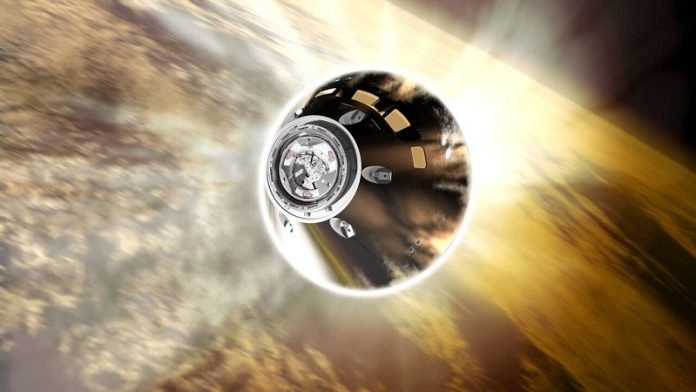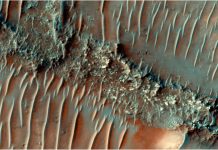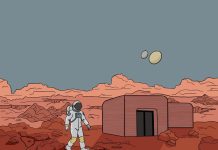
At one time, the idea of sending humans to Mars either seemed like a distant prospect or something out of science fiction.
But with multiple space agencies and even commercial space companies planning to mount missions in the coming decade, the day when humans will go to Mars is fast approaching the point of realization.
Before this can happen, several issues need to be resolved first, including a myriad of technical and human factors.
In any discussion about crewed missions to Mars, there are recurring questions about whether or not we can mitigate the threat of radiation.
In a new study, an international team of space scientists addressed the question of whether particle radiation would be too great a threat and if radiation could be mitigating through careful timing.
In the end, they found that a mission to Mars is doable but that it could not exceed a duration of four years.
The research was led by Mikhail Dobynde, a researcher from the Skolkovo Institute of Science and Technology and the Russian Academy of Science in Moscow.
He was joined by members from the GFZ German Research Centre for Geosciences at the Helmholtz Centre Potsdam in Germany, the University of California Los Angeles (UCLA), and the Massachusetts Institute of Technology (MIT).
For the sake of their study, the team considered the threat posed by the two main types of radiation sources: Solar Energetic Particles (SEP) and Galactic Cosmic Rays (GCR).
The former consists of fast-moving protons, electrons, and high-energy atomic nuclei that can negatively affect electronics and living tissue.
The latter consists of the same range of energetic particles but originate beyond the Solar System and are attributed to supernovas.
The intensity of both of these radiation sources depends on the level of solar activity, where SEP levels are least intense during a solar minimum, but GCR activity is most enhanced.
The reverse is also true, where GCR activity will be lowest during solar maximum, but SEP will be elevated. To gauge the threat posed by these sources, the team combined geophysical models that considered how particle radiation varies during the 11-year solar cycle.
These were combined with models of how radiation will affect human passengers (including different bodily organs) and their spacecraft.
The team then ran a series of Monte-Carlo simulations of radiation propagation that took into account 10 different types of SEP radiation and 28 types of fully-ionized GCR elements.
From this, they determined that the best time to send a Mars-bound mission would be during the six to twelve months after solar activity peaks (aka. solar maximum).
At this point, GCR activity is at its lowest, and SEP begins to decrease from its highest intensity. The situation slowly reverses during the next six and a half years, with GCR activity slowly increasing until it reaches maximum intensity (coinciding with a solar minimum).
Given that the average flight time to Mars is about nine months, a crewed return-mission to Mars could be done in less than two years.
According to their findings, Dobynde and his colleagues found that this would ensure that the mission made it home before the radiation environment became too hazardous.
But a mission that lasted up to four years would be pushing it since they would be forced to return home amid higher levels of GCR activity. Hence, their modelling also indicated that the spacecraft’s shielding would need to be relatively thick to ensure the crew’s health.
However, these same results also indicated that having shielding that is too thick might actually increase the amount of secondary radiation to which the crew is exposed.
This phenomenon, where high-energy particles collide with shielding to produce a cascade of secondary particles (aka. a “particle shower”), has been studied extensively aboard the International Space Station (ISS).
According to Yuri Shprits, the head of space physics and space weather at GFZ Research Centre for Geosciences (and a co-author on the paper), these results could be of great value to future mission planners.
“This study shows that while space radiation imposes strict limitations on how heavy the spacecraft can be and the time of launch, and it presents technological difficulties for human missions to Mars, such a mission is viable,” he said.
These considerations are vital given that there are multiple plans to conduct regular missions to Mars in the near future.
This includes NASA and its Moon to Mars mission architecture, China’s plans to send crews to Mars by 2033 (and build a permanent research outpost there), and Elon Musk’s plan for sending payloads and crew every two years using the SpaceX Starship and Super Heavy launch vehicle.
These are just a few of the visions for Martian exploration (and settlement) that have been articulated of late. With all of the robotic missions currently exploring the planet and the possibility of human exploration on the horizon, Mars is looming in the public imagination once again. Since the Apollo era, Mars has come to be viewed as the “next great leap” that could lead to a new era reinvigorated space age!
The fact that Mars is the most habitable celestial body beyond Earth has also been a source of inspiration to scientists, mission planners, astronauts, and futurists alike.
Despite the challenges that going there would entail, there is currently no shortage of people willing to sign-up for a one-way trip.
For these adventurous souls, the prospect of breaking ground on Mars – the next great “frontier” – has a certain romance to it.
But what is especially exciting is when realistic appraisals show that these adventurous notions are actually feasible, given the right preparations, technology, and mitigations strategies.
When scientific fact and romance come together to make plans for the future, great things can happen!
Written by Matt Williams.
Source: Universe Today.



